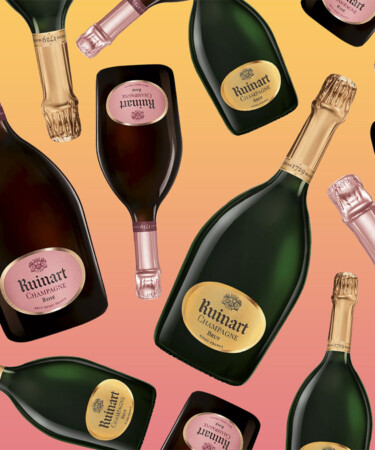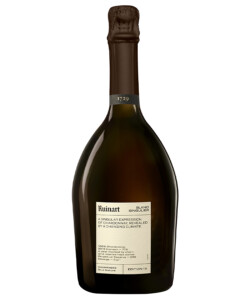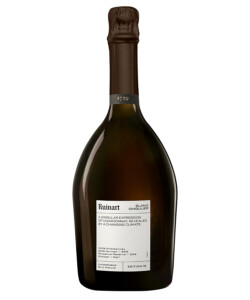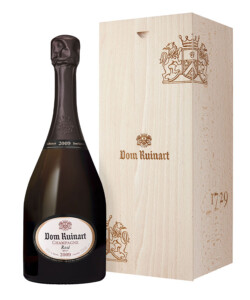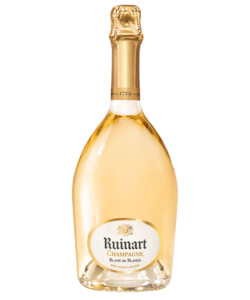When Nicolas Ruinart established Maison Ruinart in 1729, the Ruinart family was known for their role in society as wealthy cloth merchants. But that all changed with Nicolas’s uncle, Dom Thierry Ruinart, a Benedictine monk and close contemporary of Dom Pérignon. In 1680 at age 23, Dom Ruinart left his home in Champagne to study at the prestigious Abbey of Saint-Germain-des-Prés, located on the outskirts of Paris. While there, he was exposed to a more aristocratic lifestyle and observed, for the first time, people drinking “wine with bubbles.”
Upon his return to the Champagne region, the monk took up work at the Hautvillers commune, where he worked in tandem with Pérignon, learning more about the fellow monk’s vinification techniques. After Dom passed this information on to his nephew, Nicolas used it to commercially produce the stuff, and it was an instant success.
Today, Ruinart is known for its expressive, Chardonnay-dominated Champagnes packaged in bottles inspired by the house’s roots. Here are 11 more things you should know about the iconic Champagne house.
-
Maison Ruinart was the very first Champagne house.
Prior to 1728, it was practically impossible to ship sparkling wine to distant markets as it was required to be packaged in barrels. All that changed with the Edict of Louis XV, which allowed for wine to be shipped in bottles, which were necessary for Champagne to complete its signature second fermentation. One year after King Louis XV’s declaration, Nicolas Ruinart drafted the charter for Maison Ruinart, establishing the world’s first Champagne house on Sept. 1, 1729. By 1764, Maison Ruinart was shipping both brut and rosé cuvées across Europe.
-
The Champagne was originally produced as a complimentary gift.
When Maison Ruinart was founded, the Ruinart family was known for their fabric merchandising business. As such, the “wine with bubbles” (as it was still called then) was given to customers as a complimentary gift with the cloth they purchased. But just six years after the Champagne house was founded, the sparkling wine had become so popular that Nicolas disbanded the cloth-selling business to exclusively focus on Champagne production.
-
Ruinart was one of the first Champagne houses to age its wines in Reims’ ancient chalk quarries.
Just beneath the surface of the French city Reims are chalk quarries, or crayères, that date as far back as the Cretaceous period. The Saint-Nicaise quarries, which were used to build houses in the region until the 18th century, make up a labyrinth spanning approximately five miles and depths up to 125 feet. In 1877, Ruinart discovered the crayères and was among the first Champagne houses to convert the space into a cellar for aging purposes. Within the chalk cellars, conditions are near-perfect for aging, with a constant temperature of approximately 50 to 53.6 degrees Fahrenheit, near-total darkness, and no movement other than the highly controlled riddling process. Now used by other Champagne producers like Veuve Clicquot, Taittinger, and Charles Heidsieck, the Saint-Nicaise hill and chalk pits were added to the list of UNESCO World Heritage Sites.
-
The house faced a number of challenges during the World Wars.
While producing Champagne has never been an easy feat, it was particularly difficult in the early 20th century as wars ravaged the region, destroying wineries and decimating vineyards. During World War I, Reims was hit particularly hard, and all the buildings used to produce Ruinart Champagne were destroyed during the Battle of the Marne. Not to be deterred from production, André Ruinart, who was leading the house at the time, moved operations underground into the crayères to protect the business from further shelling. But just a few months later, the cellars flooded. Ruinart, still unwilling to cease operations, set up his office on a floating raft in the flooded cellars until it was safe to be above ground once more. The house was able to stabilize and its former buildings were restored, but the success was short-lived: During World War II, the creyéres were raided by invading Nazi forces who wiped out the house’s entire collection of Champagne. To this day, there are no vintages in Ruinart’s own cellars that date prior to 1945.
-
The Ruinart family controlled the maison for over two centuries.
After two decades of initial and massive success, the early 20th century saw Maison Ruinart facing tremendous financial difficulties as a result of two World Wars and a global financial crisis. In 1947, Bertrand Mure, a member of the Ruinart family on the maternal side, took over as head winemaker, though he was still unable to turn things around. In the 1950s, Mure requested financial assistance from Baron Philippe de Rothschild, which boosted the maison for a short period of time. In 1963, the Ruinart family sold the Champagne house to fellow Champagne producer Moët & Chandon. Twenty-four years later, Ruinart was folded into the LVMH umbrella when Louis Vuitton and Moët Hennessy merged to form the luxury conglomerate.
-
Ruinart’s distinctive bottle shape is a tribute to historic Champagne vessels.
While many Champagne bottles are tall and lean, Ruinart bottles have a shorter, squatter base and slightly elongated neck that make them stand out on shelves. According to the brand, this distinctive shape is meant to replicate those used to house sparkling wine in the early days of Champagne production. In 1735, artist Jean-François de Troy painted “Le Déjeuner d’Huîtres,” or “The Oyster Dinner,” which depicts its subjects drinking Champagne for the first known time in art history. In the painting, which is currently on display at Musée Condé in Chantilly, the bottles have tall, sleek necks and wider, bulging bases — just like those now used to house Ruinart’s Champagnes.
-
Chardonnay is central to the house’s signature style.
Champagne production is synonymous with three grape varieties: Chardonnay, Pinot Noir, and Pinot Munier. But while other houses tend to use a near-equal proportion of Chardonnay and Pinot Noir (with the latter predominantly used as a blending variety), Ruinart is known for its celebration of the white wine grape. Chardonnay is, of course, the sole grape used in the brand’s non-vintage Blanc de Blancs. But it’s also the only grape used in Dom Ruinart, the maison’s most prestigious vintage offering consisting of fruit exclusively sourced from grand cru vineyards. In Dom Ruinart Rosé expressions, Chardonnay makes up the vast majority of the blend, accounting for 85 percent of the cuvée.
-
Ruinart Blanc Singulier demonstrates climate change’s impact on grape growth.
With harvests beginning earlier and earlier, Maison Ruinart was inspired to create Ruinart Blanc Singulier, a line of blended Champagnes only produced during years marked by unusual harvests spurred by atypical climate. Each wine in the series is made from 100 percent Chardonnay, with 80 percent of the blend made up of wines from the specific year and the remaining 20 percent from reserve wines made exclusively for the cuvée. The 2018 harvest, marked by an unusually warm and sunny growing season and increased average yearly temperature, is on display in the line’s most recent edition, Edition 18. The Champagne, which spent three years aging in the cellar, is slightly sweet and delivers candied fruit aromas and a tart palate of lemon zest and honey.
-
The brand takes aging further than required.
While the region mandates that all non-vintage Champagnes be aged for a minimum of 15 months, Ruinart sees non-vintage wines age for anywhere between two and three years to allow for optimal aromatic richness. The situation is similar for the brand’s vintage Champagnes, which all age for a minimum of five years, despite the AOC only demanding three. Dom Ruinart Blanc de Blancs ages for the longest of Ruinart’s Champagnes, spending a minimum of nine years aging on the lees before they are disgorged by hand. The Champagne is characterized by brioche aromas and an expressive, crisp palate marked by notes of orange blossom and lemon curd.
-
The house is committed to lowering its carbon footprint and promoting sustainable viticulture.
Since 2003, the Champagne region has experienced five early harvests due to climate change, prompting Ruinart to take action to protect its vineyard. Over the past two decades, the use of fertilizers, insecticides, and fungicides has been reduced by approximately 50 percent, and herbicides have been completely eliminated from vineyard management practices. In 2012, the Champagne house converted to electric tractors to reduce their carbon output in the vineyard. Three years later, the maison introduced the use of a green cooling liquid made from fermented corn sugar for disgorgement that requires approximately 40 percent less product and cuts back on energy consumption by 20 percent. The Champagne house also eliminated the use of all aerial transport when shipping its product, instead opting for 85 percent of international deliveries to be fulfilled by ship and the remaining 15 percent by land.
Promoting biodiversity is another company priority. At home, the maison works in tandem with Reforest’Action to fulfill its pledge to plant 25,000 trees and shrubs in the Taissy vineyard to restore native flora and fauna. Globally, the Champagne house has collaborated with Conservation International, the world’s largest tropical forest restoration organization, to help conserve over 50,000 trees worldwide.
-
Ruinart has a strong connection to the arts.
Since the late 19th century, Ruinart has been intimately connected to the artist community. In 1896, the house effectively created one of France’s first advertisements when Andre requested Alphonse Mucha, a Czech artist, draw an illustration of his product. In 2008, the brand established the Carte Blanche project, founded on the belief that “art can enlighten and connect us across time and places.” Over the past 16 years, the brand has collaborated with a new artist every year to pay homage to its legacy and raise awareness of climate change. For the 2024 collaboration, Ruinart partnered with six artists across the globe to produce Conversations With Nature, an installation meant to question humans’ relationship with other living things.
